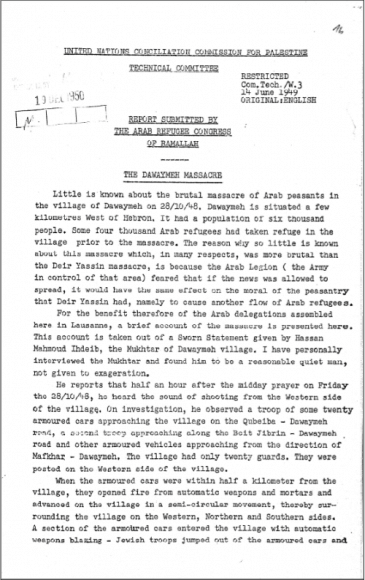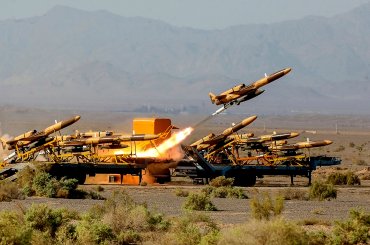A few days ago I covered the testimony of an Israeli soldier witnessing the Dawaymeh massacre at the end of October 1948. Haaretz had published the letter in full for the first time, in an article by Israeli historian Yair Auron.
A reader, Richard Lightbown, subsequently contacted Mondoweiss with a citation to a contemporary UN report on the massacre (by the UN Conciliation Commission for Palestine Technical Committee). I checked with the UN Dag Hammerskjold Library, which confirmed the authenticity of the report and referred me to an electronic version (here). (The original link to a PDF scan is temporarily broken).
Once again, we speak of a document on this massacre where the contents have been publicized before in excerpt by others. Whilst we are thus not speaking of a letter which sees full daylight for the first time, this is still a document which probably few have read in full. In light of the focus on Dawaymeh (also spelled Dawayima), as a follow-up – this is another angle of the massacre. This letter regards sworn testimony by the village Mukhtar (leader) Hassan Mahmoud Ihdeib, who cites the massacre victims to be at least 145 in two main locations – the mosque (60) and the nearby cave Iraq El Zagh (85) – plus a large number of bodies in the street. This corresponds with historian Benny Morris’s assessment of ‘hundreds’. It is important to note here that testimonies vary, and can be a partial view; the Mukhtar came back to the village only a day later. Historian Ilan Pappe in his summation of sources estimates a total of 176 killed in the mosque, out of a total of 426 men, women and children.
The letter also regards the massacre as “more brutal than Deir Yassin massacre” – a view that is echoed in the Israeli testimony brought forth in S. Kaplan’s letter. It is also interesting, that the letter concerning the Mukhtar testimony states “the reason so little is known about this massacre…is because the Arab legion…feared that if the news was allowed to spread, it would have the same effect on the morale of the peasantry that Deir Yassin had, namely to cause another flow of Arab refugees.” Yet Auron covers how the massacre, which was known about by Prime Minister David Ben-Gurion, did not seem to be good PR for the military leadership at the point.
My view is that the leadership was also in a very different paradigm than at the time of the Deir Yassin massacre in April 1948. Then it was the Irgun and Stern Gang, the terrorist underground organisations, which were informed by the ultra-nationalist Revisionist ideology of Jabotinsky. They were to the right of Ben-Gurion, so he and the more mainstream ‘labor’ leadership could thus both profit from the terror and the Palestinian flight that it caused, whilst distancing themselves from it and portraying it as a rogue act. After the declaration of the state in May 1948, Ben Gurion outlawed these organisations and had their members incorporated into the Israeli Defense Forces. Thus massacres committed after the declaration could no longer be attributed to ‘others’, and the Israeli leadership had to be more cautious about its portrayal – so as not to resemble a rogue state.
The case was kept quiet inside closed government deliberations whose minutes are classified to this very day. A one-man ‘investigative committee’ manned by then State Attorney Yaakov Shimshon Shapira was appointed, yet his conclusions were never published. They also are classified to this very day. The military investigation by Isser Beeri is said by Auron to “not have been completed, and [to have] died out after the general amnesty given in February 1949”. The results of that investigation, too, are classified to this very day.


Transcript:
UNITED NATIONS CONCILIATION COMMISSION FOR PALESTINE
TECHNICAL COMMITTEE
RESTRICTED. Com. Tech /W.3
14 June 1949
ORIGINAL ENGLISH
REPORT SUBMITTED BY THE ARAB REFUGEE CONGRESS OF RAMALLAH
————————–
THE DAWAYMEH MASSACRE
Little is known about the brutal massacre of Arab peasants in the village of Dawaymeh on 28/10/48.* Dawaymeh is situated a few kilometers west of Hebron [Al Khalil]. It had a population of six thousand people. Some four thousand Arab refugees had taken refuge in the village prior to the massacre. The reason why so little is known about this massacre which in many respects, was more brutal than Deir Yassin massacre, is because the Arab Legion (the army in control of that area) feared that if the news was allowed to spread, it would have the same effect on the moral of the peasantry that Deir Yassin had, namely to cause another flow of Arab refugees.
For the benefit therefore of the Arab delegations assembled here in Lausanne, a brief account of the massacre is presented here. This account is taken out of a Sworn Statement given by Hassan Mahmoud Ihdeib, the Mukhtar of Dawaymeh village. I have personally interviewed the Mukhtar and found him to be a reasonable quiet man, not given to exaggeration.
He reports that half an hour after the midday prayer on Friday the 28/10/48*, he heard the sound of shooting from the western side of the village. On investigation, he observed a troop of some twenty armoured cars approaching the village on the Qubeiba-Dawaymeh road, a second troop appraoching along the Beit Jibrin-Dawaymeh road and other armoured vehicles approaching from the direction of Mafkhar-Dawaymeh. The village had only twenty guards. They were posted on the western side of the village.
When the armoured cars were within half a kilometer from the village, they opened fire from automatic weapons and mortars and advanced on the village in a semi-circular movement, thereby surrounding the village on the western, northern and southern sides. A section of the armoured cars entered the village with automatic weapons blazing – Jewish troop jumped out of the armoured cars and spread out through the streets of the village firing promiscuously at anything they saw. The villagers began to flee the village while the older ones took shelter in the mosque and others in a nearby cave called Iraq El Zagh. The shooting continued for about an hour.
The following day, the Mukhtar met with the villagers and agreed to return to the village that night to find out the fate of those that had stayed behind. He reports that in the mosque there were the bodies of some sixty persons, most of them were men of advanced age who had taken shelter in the mosque. His father was among them. He saw a large number of bodies in the streets, bodies of men, women and children. He then went to the cave of Iraq El Zagh. He found at the mouth of the cave the bodies of eighty five persons, again men, women and children.
The mukhtar then carried out a census of the inhabitants of the village and found that a total of 455 persons was missing of whom 280 were men and the rest women and children.
There were other casualties among the refugees, the number of which the Mukhtar was unable to determine.
The Mukhtar explicitly states that the village had not been called upon to surrender and that the Jewish troops had not met with any resistance.
It need hardly be mentioned that this brutal and unprovoked attack occured during the truce.
Secretary
DELEGATION
ARAB REFUGEE CONGRESS
*It appears that the UN got the date wrong by a day: it was no doubt the 29th of October and not 28th, which is also supported elsewhere – the Mukhtar had no doubt been correct about the Friday as it has typical prayer traditions different from other days. Thanks to Khalid S. Barghouti for noticing this discrepancy in my consultation with him concerning this historical source.



Al Dawayimah was well in that part of Palestine designated by the U.N. as part of the Arab state. The zionists were conquering more territory in this operation. See http://www.palestineremembered.com/Hebron/al-Dawayima/
The massacre at Safsaf was on the same day, Oct 29, 1948. Safsaf is a little village near Safed in northern part of Palestine. There were about 70 men lined up and shot, and several girls raped. After that, most of the survivors fled to Lebanon.
‘My view is that the leadership was also in a very different paradigm than at the time of the Deir Yassin massacre in April 1948. Then it was the Irgun and Stern Gang, the terrorist underground organisations, which were informed by the ultra-nationalist Revisionist ideology of Jabotinsky. They were to the right of Ben-Gurion, so he and the more mainstream ‘labor’ leadership could thus both profit from the terror and the Palestinian flight that it caused, whilst distancing themselves from it and portraying it as a rogue act.’
Flash forward to 2014:
Israel’s Military Occupation
by Moriel Rothman-Zecher/August 1, 2015@21:26
Context, or, Why pro-occupation Israeli politicians’ condemnation of Ali Saad Dawabshe’s murder are not really condemnations at all
I just got home from the rally at Zion Square, and the parts of the rally that addressed the murder of 18 month-old Ali Saad Dawabshe left me feeling deeply upset, rather than hopeful.
Indeed, such condemnations have come from virtually every corner of the Israeli political spectrum, from Prime Minister Benjamin Netanyahu’s branding it as “terrorism,” to Opposition Leader Isaac Herzog’s statement that “Jewish terrorists” should have their homes demolished and put be put under administrative detention “just like Muslim terrorists” [further emphasizing how radically undeserving he is of the title “Opposition Leader” or “Left-wing;” as if suggesting an increase in horrid, draconian acts of collective punishment is somehow a progressive position to take…].
But such condemnations are not heartening. They are the opposite: They are nauseating.’
‘But Ali Saad Dawashbe wasn’t murdered simply as the result of a few bad apples. He was murdered as the result of a 48-year military occupation which treats Palestinians as if they are worth less than Jews, and employs extreme and constant violence in order to maintain this system of inequality. Were the people who carried out this murder truly “straying from the path?” Or were they just enacted a vigilante form of the policy of collective punishment that characterizes the occupation?’
That was 2015, this is now:
‘Netanyahu plans fence around Israel to protect it from ‘wild beasts’
Israeli PM says proposed barrier would also solve problem of Hamas tunnels from Gaza, but plan already has critics in his own cabinet.
The real face of israel and their intent wrt Palestinians is crystal clear. Any American who believes anything that comes out of an israeli official’s mouth is a damn fool. I don’t even think most American’s believe it really, they’re been raised on having their opinions and news of the world given to them in an entertainment format, blurring the lines between fantasy and fiction to the point they just accept whatever they’re being told. They’re not free to question, boycott, demonstrate or anything else the so-called founding father’s had in mind for them.
Attacked during the truce? It seems nothing has changed to the current day with respect to the tactics employed by the worlds most cowardly army.